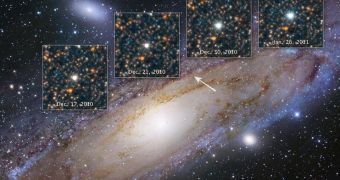Though nearly everyone has heard about the NASA Hubble Space Telescope, not everyone knows what the machine's namesake, astronomer Edwin Hubble, did in order to gain so much attention. His main work was showing that the Universe extends beyond our galaxy, and a single star helped him do this.
Back in the early 20th century, astronomers were convinces that structures such as the Andromeda galaxy – the closest galactic neighbor the Milky Way has – were “spiral nebulae,” structures that existed only within our galaxy.
In this sense, they viewed our home galaxy as an island of stars in an otherwise empty Universe. But there were those who proposed – without any evidence, mind you – that the Milky Way was just one such island, in a sea of many others.
Edwin Hubble was the first to demonstrate that this is indeed true, and the way he did this was by analyzing a star called V1, located at the outskirts of Andromeda. The single variable star is part of a class of stellar objects that astronomers now call Cepheid variables.
At this point, they are used to measure cosmic distances with tremendous accuracy. Back in 1923 however, observations of the star were used by Hubble to demonstrate that Andromeda is not a part of the Milky Way, but rather a distinct galaxy in its own right.
Now, more than 90 years after the initial discoveries, the Hubble Space Telescope has been pointed at the V1 Cepheid variable again, in honor of the famed astronomer and his work, Daily Galaxy reports.
The investigation was conducted by researchers with the Space Telescope Science Institute's Hubble Heritage Project, in collaboration with colleagues at the American Association of Variable Star Observers (AAVSO).
AAVSO experts carried out a 6-month survey of V1, producing a map of its light curve. This represents the variations in brightness that the celestial object displays, as viewed from Earth. These data were then transmitted to the Hubble team, which carried out observations based on them.
“V1 is the most important star in the history of cosmology,” explains astronomer Dave Soderblom , who holds an appointment with the Baltimore, Maryland-based STScI.
“It's a landmark discovery that proved the Universe is bigger and chock full of galaxies. I thought it would be nice for the Hubble telescope to look at this special star discovered by Hubble, the man,” the expert goes on to say. He was the one who proposed the new survey.
“This observation is a reminder that Cepheids are still relevant today. Astronomers are using them to measure distances to galaxies much farther away than Andromeda. They are the first rung on the cosmic distance ladder,” Hubble Heritage team member Max Mutchler concludes.

 14 DAY TRIAL //
14 DAY TRIAL //